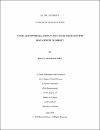Vascular Endothelial Dysfunction as the Mechanism for Development of Obesity
| المرشد | Malki, Ahmed |
| المؤلف | Dalloul, Raja’a Saleh |
| تاريخ الإتاحة | 2018-12-13T07:38:31Z |
| تاريخ النشر | 2018 |
| الملخص | Obesity is one of the major public health issues in the world with a rapid increase in its prevalence. According to the last public health report from supreme public health in Qatar in 2012, 71.8 % of the women were overweight compared to 68.3% of men. Adipocytes are where their size can vary with different food intake. The rapid expansion of the adipose tissue requires high vascularization to support their expansion. Branching of vasculature depends on properly functioning endothelial cells of the vessels. Different diseases including diabetes and obesity has been reported to cause defects in the endothelial cell function. This defect could be due to changes in nitric oxide production which regulate vascular contractility or production of other oxyradicals leading to damage to the tissue. Calreticulin (CRT) is a multifunctional protein localized in the endoplasmic reticulum of all mammalian cells. The main functions of CRT are regulation of intracellular Ca2+ hemostasis and chaperone. Our transgenic mouse model overexpressing CRT in endothelial cells (ECCRT+) showed evidence of endothelial dysfunction and susceptibility to obesity and diabetes as they age. Therefore, we hypothesized that overexpression of CRT in endothelial cells results in endothelial dysfunction that increases angiogenesis leading to activation of adipogenesis. In our study we examined changes in the phenotype of adipocytes of wild type (wt) and ECCRT+ mice fed either high fat (60%) or regular fat (10%) diet for different time points (8-24 weeks). Our results illustrated that these mice expressed lower eNOS thus leading to endothelial dysfunction. The Glucose tolerance test (GTT) assay illustrated that ECCRT+ mice developed diabetes as they aged when on 10% fat diet. However, on high fat diet they failed to regulate blood glucose even at 8 weeks. Histological analysis of the wt and ECCRT+ mice showed significant changes in the adipocyte size and number suggesting a possible association between endothelial dysfunction and adipogenesis. Our study is the first to show an important role of endothelial dysfunction in altering adipogenesis process leading to the development of obesity and diabetes. Our data also highlights the importance of an endoplasmic reticulum chaperone in this process. |
| اللغة | en |
| الموضوع | Obesity public health vascularization Calreticulin ECCRT+ |
| النوع | Master Thesis |
| التخصص | Biomedical Sciences |
الملفات في هذه التسجيلة
هذه التسجيلة تظهر في المجموعات التالية
-
العلوم الحيوية الطبية [69 items ]


